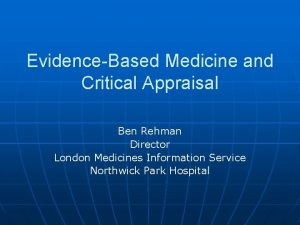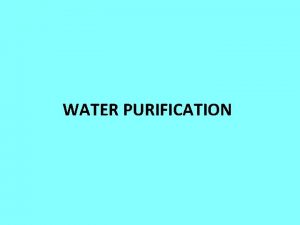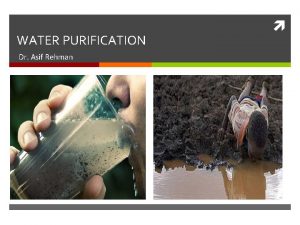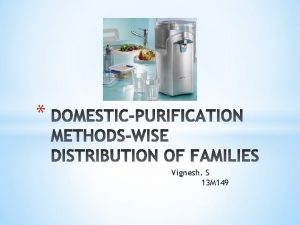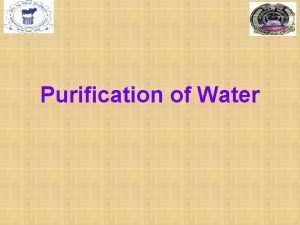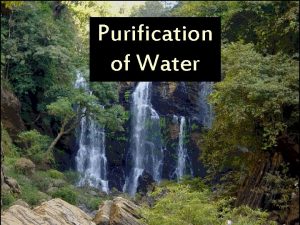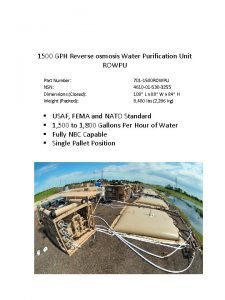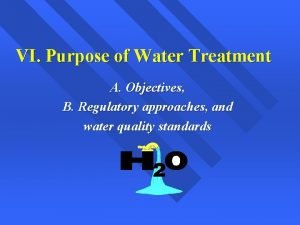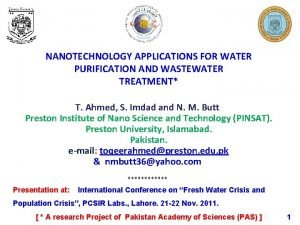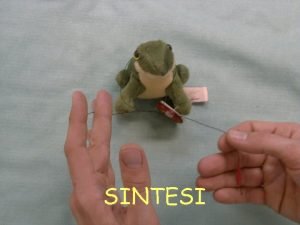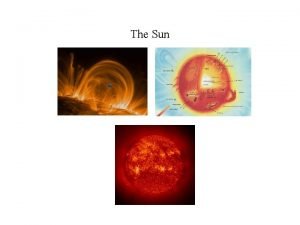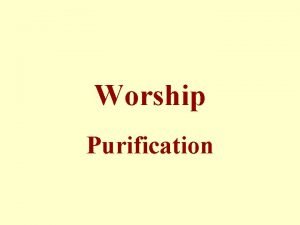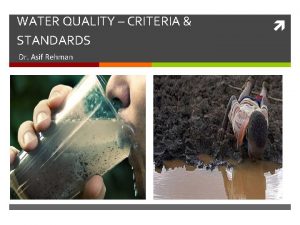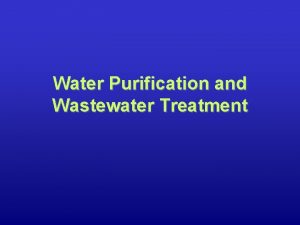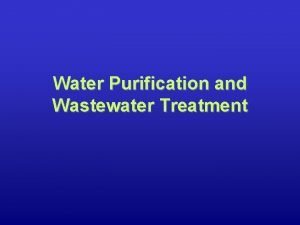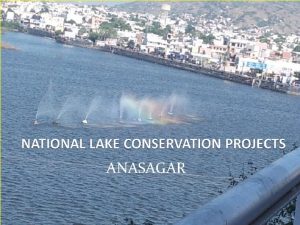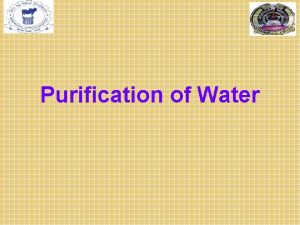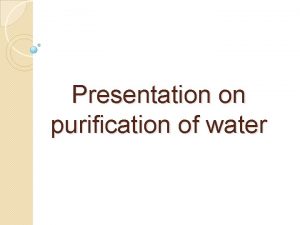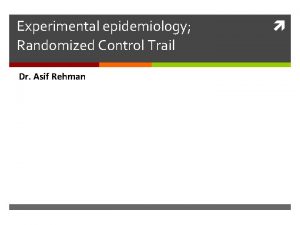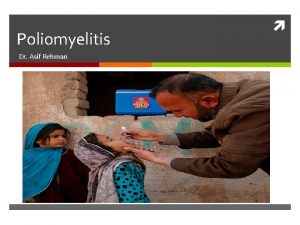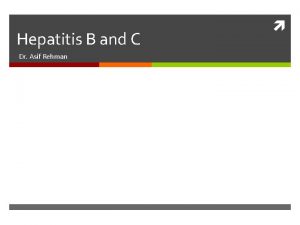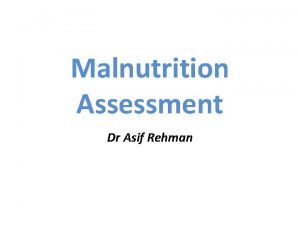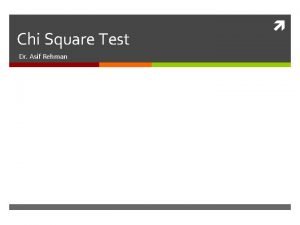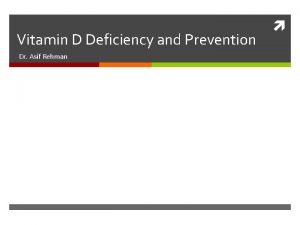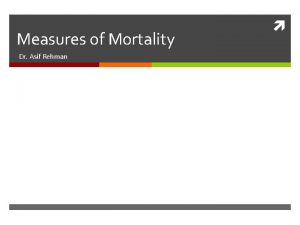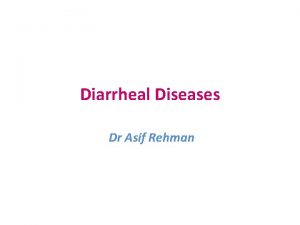WATER PURIFICATION Dr Asif Rehman WHO Fact Sheet






















- Slides: 22

WATER PURIFICATION Dr. Asif Rehman

WHO Fact Sheet In 2015, 91% of the world’s population had access to an improved drinking-water source, compared with 76% in 1990. 2. 6 billion people have gained access to an improved drinking-water source since 1990. 4. 2 billion people now get water through a piped connection; 2. 4 billion access water through other improved sources including public taps, protected wells and boreholes. 663 mln people rely on unimproved sources, including 159 mln dependent on surface water. Globally, at least 1. 8 billion people use a drinking-water source contaminated with faeces. Contaminated water can transmit diseases such diarrhea, cholera, dysentery, typhoid and polio. Contaminated drinking-water is estimated to cause 502000 diarrheal deaths each year. In low- and middle-income countries, 38% of health care facilities lack any water source, 19% do not have improved sanitation and 35% lack water and soap for hand washing

A: Biological (Water born diseases) 1 Caused by the presence of an infective agent Diseases a Viral Hepatitis A & E, Poliomyelitis, rota virus diarrhea b Bacterial Typhoid & paratyphoid, bacillary dysentery, E coli, cholera c Protozoal Amoebiasis, Giardiasis d Helminthic Round warm, threadworm, hydatid disease 2 Presence of aquatic host Diseases a Snail Schistosmoiasis b Cyclops Guineaworm, fish tape worm

B: Chemical 1 Caused by the presence of chemicals Diseases a Fluoride Fluorosis (Mottling of dental enamel) b Nitrate Methaemoglobinemia 2 Due to inadequate use of Diseases water a Inadequate use Shigellosis, trachoma, conjunctivitis, ascariasis, scabies 3 Due to insects breeding in water Diseases a Insects breeding Malaria, Filaria, arbovirus, African trypanosomiasis

Hardness of Water Hardness of water is the soap destroying power of water. The consumer considers water hard if large amount of soap is required to produce lather. It is caused by 4 dissolved compound: 1) Calcium bicarbonate 2) Magnesium bicarbonate 3) Calcium sulphate 4) Magnesium sulphate. Hardness can be classified in to carbonate and non-carbonate. The hardness of water is expressed in terms of mille- equivalents per liter m. Eq/L. One m. Eq/L of hardness producing ion is equal to 50 mg Ca. CO 3 (50 ppm) in one liter of water. Drinking water should be moderately hard (1 -3 m. Eq/L).

Disadvantages of Hardness It consumes more soap and detergent. When heated the carbonates are precipitated and bring about furring or scaling of boilers. Furring and scaling leads to great fuel consumption, loss of efficiency and some times causes boiler explosion. It adversely affect cooking, food cooked in soft water remains its natural color and appearance. Fabrics washed in hard water do not have a long life. Hardness shortens the life of pipes and fixtures.

Water Purification It may be considered under two headings: 1. Purification of water on large scale 2. Purification of water on small scale

Water Purification of water on large scale: 1. Storage 2. Filtration (slow sand/biological filters), (Rapid sand/mechanical filter) 3. Disinfection (chlorination)

Water Purification of water on small scale: Household purification of water: The methods are generally available for purifying water on an individual or domestic scale can be used singly or in combination.

Water Purification of water on small scale: Household purification of water: 1. Boiling 2. Chemical disinfection 3. Filtration 4. Ultraviolet irradiation

Water Purification of water on small scale: Household purification of water: 1. Boiling To be effective the water must be brought to a rolling boil for 10 – 20 min. It kills all bacteria, spores, cysts, and ova and yields sterilized water. It also remove temporary hardness. Taste of water is alters but it is harmless.

Water Purification Household purification of water: 1. Chemical disinfection Bleaching powder Chlorine solution High test hypochlorite Chlorine tablets Iodine Potassium permanganate

Water Purification Household purification of water: Filtration: water can be purified on small scale by filtering through ceramic filter. The essential part of the filter is candle which is made of porcelain in the chamber-land type. In Katadyn filter the surface of the filter is coated with a silver catalyst so that the bacteria coming in contact with the surface are killed by the “oligodynamic” action of the silver ion which are liberated in to the water. Filter candles usually removes bacteriae but not the filter passing viruses

Water Purification Household purification of water: Filtration: Filter candles are liable to be logged with impurities and bacteriae. They should be cleaned by scrubbing with a hard brushes under running water and boiled at least once a week.

Water Purification Ultraviolet irradiation: Germicidal properties of UV rays have been recognized for many years. UV irradiation is effective against most micro organisms like bacteria, yeast, viruses, fungi, algae, protozoa etc The method involves the exposure of film of water up to about 120 mm thick to one or several quartz mercury vapor arc lamps emitting UV radiation at a wavelength of 254 nm. The advantages are that the exposure is for short period. No taste and odor produced and over exposure does not results any harmful effect. . The disadvantage is that the apparatus is expensive

Water Purification Disinfection of wells: Wells are the main source of water supply in rural areas. The need often arises to disinfect them sometimes on a mass scale during epidemics of cholera or gastroenteritis. The most effective and cheapest method is by bleaching powder. Potassium permanganate should not be used.

Water Purification Steps in well disinfection: Roughly 2. 5 gm. of good quality of beaching powder would be required to disinfect 1000 liters of water. This will give an app dose of 0. 7 mg of applied chlorine per liter of water. The bleaching powder required for disinfecting wells is placed in a bucket not more than 100 gm and made in to thin paste. More water is added till the bucket is nearly three fourth full. The contents are stirred well and allowed to sediment when lime is settle down. The supernatant is a chlorine solution. The bucket containing chlorine sol is lowered below water surface and water is agitated by moving bucket violently vertically & laterally so that the sol mixes with water. And a contact period of one hr is allowed before water can be used.

Water Purification Steps in well disinfection: Orthotolidine arsenite test is best to test for residual chlorine at the end of one hour contact. If the level is less than 0. 5 mg/l the chlorination process should be repeated.

Water Purification Double pot method: Double pot method is effective method. This pot has two cylindrical pots one placed inside the other. The inside pot height and diameter in 30 cm and 25 cm respectively. A hole 1 cm in diameter is made in each pot. In the inner pot the hole is in the upper portion and in the outer pot it is in the bottom. A mixture of 1 kg of Bleaching Powder and 2 kg of sand is prepared in slightly mixed with water and filled the inner pot slightly below the upper hole.

Water Purification Double pot method: The mouth of the double pots is closed with polyethylene foil. The double pot is lowed in to the well. The pot is immersed at least 1 m below water level This method works satisfactory for 2 -3 weeks in a well containing bout 4, 500 liter of water.

Class Exercise 1 Caused by the presence of chemicals Write 1 Diseases names a Fluoride ? b Nitrate ? Due to inadequate use of water Write 3 Diseases names Inadequate use ? Due to insects breeding in water Write 2 Diseases names Insects breeding ? Caused by the presence of an infective agent Write 2 Diseases names a Virus ? b bacteria ? c Protozoa ? 2 a 3 a 4

Water Quality THANK YOU
 Water and water and water water
Water and water and water water Fasih ur rehman
Fasih ur rehman Dr waheed rehman
Dr waheed rehman Tahira rehman
Tahira rehman Abdul rehman chughtai paintings
Abdul rehman chughtai paintings Ben rehman
Ben rehman Need of water purification
Need of water purification Double pot method water purification
Double pot method water purification Introduction of purification of water
Introduction of purification of water Double pot method water purification
Double pot method water purification Difference between slow and rapid sand filter
Difference between slow and rapid sand filter Feninax
Feninax Rowpu 1500 technical order
Rowpu 1500 technical order Water treatment objectives
Water treatment objectives Objective of water purification
Objective of water purification Minahil asif
Minahil asif Ltad nedir
Ltad nedir Dr asif hanif
Dr asif hanif Amir asif
Amir asif Dacron graft
Dacron graft Asif international
Asif international Asif əsgərov
Asif əsgərov The sun fact sheet
The sun fact sheet





